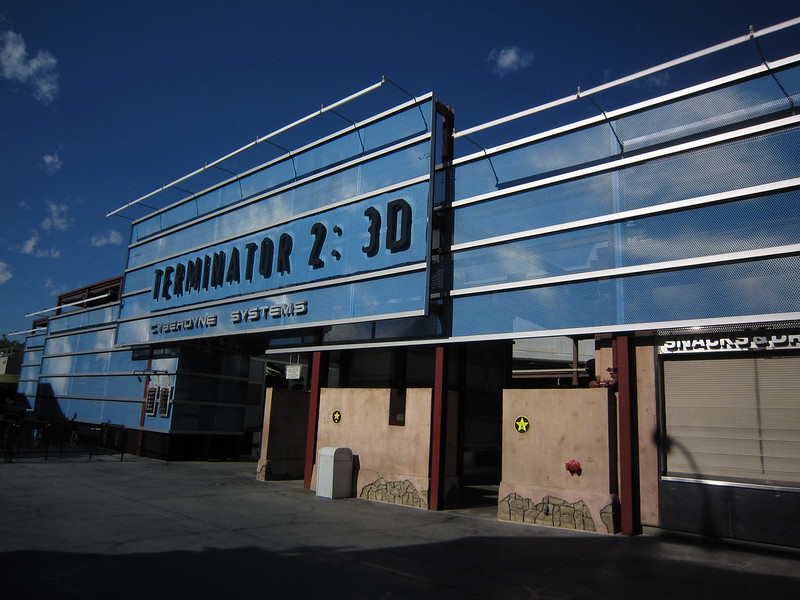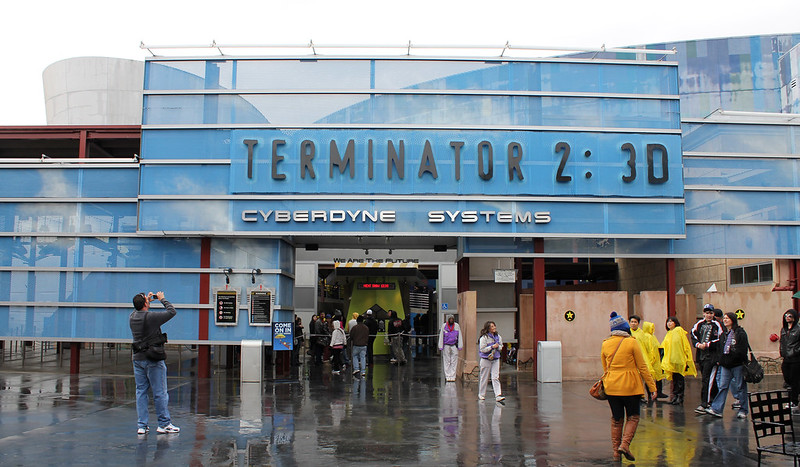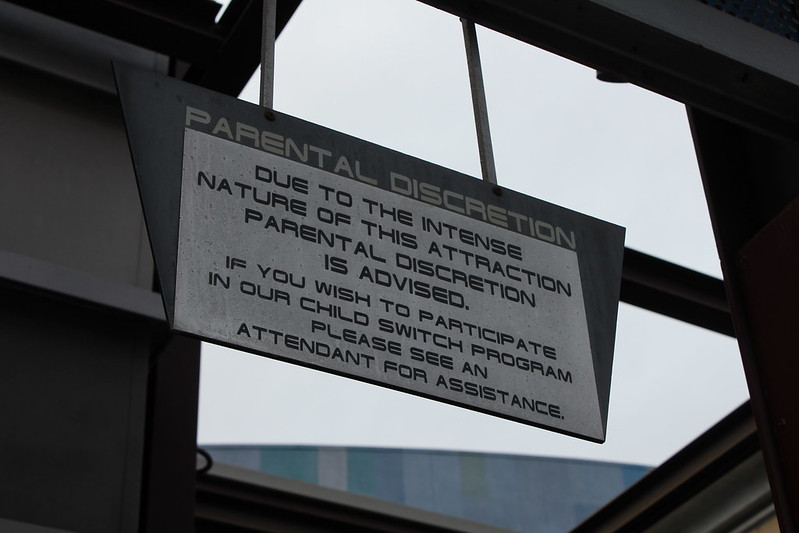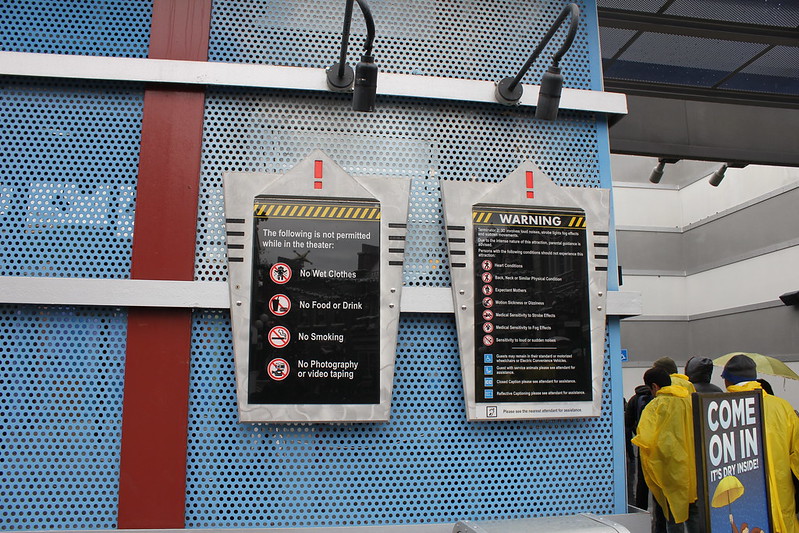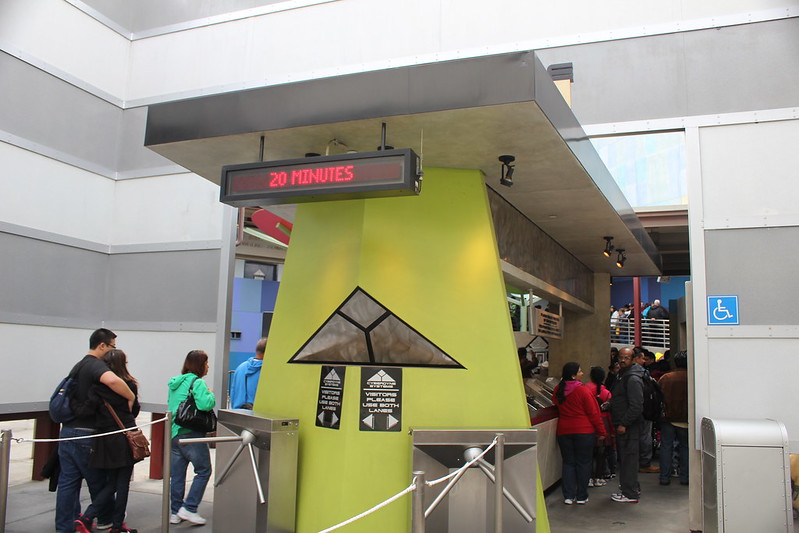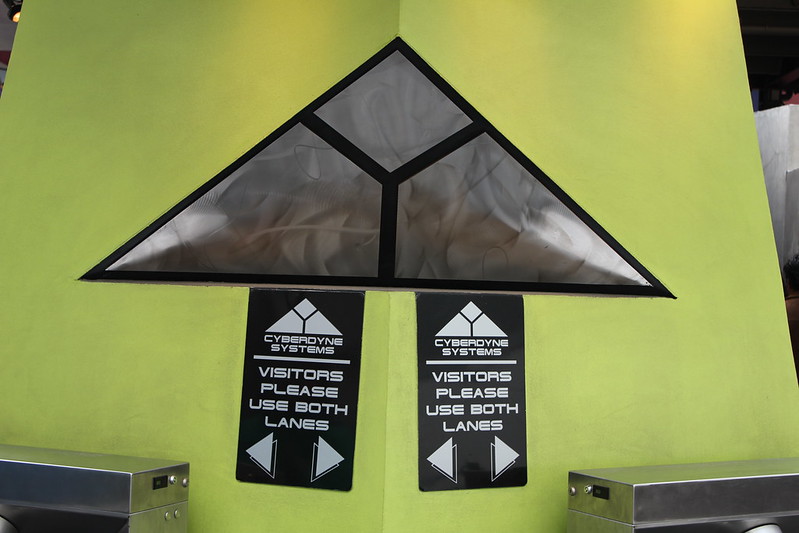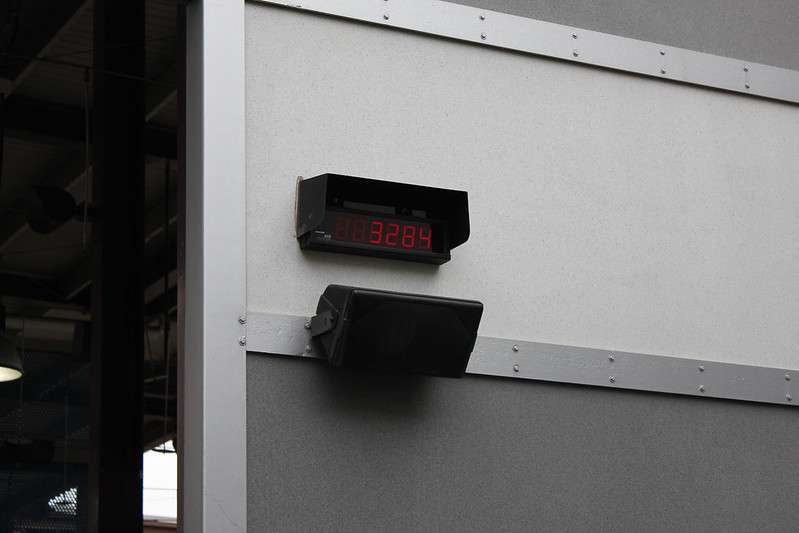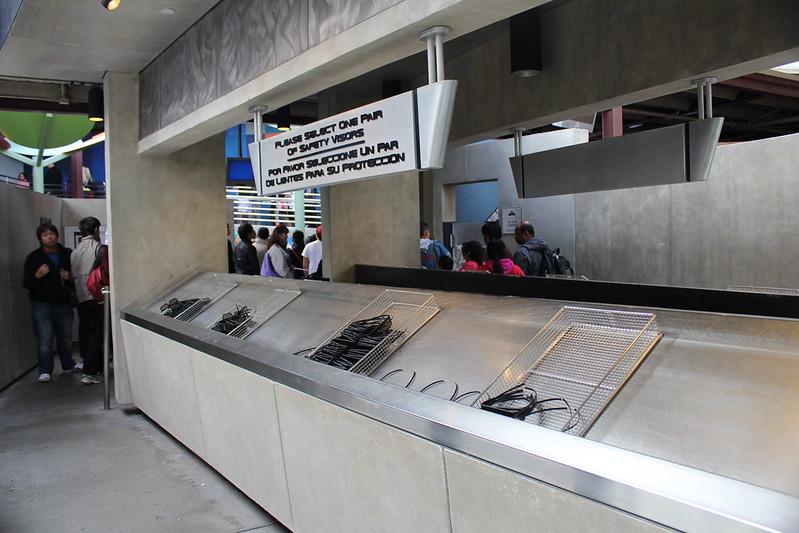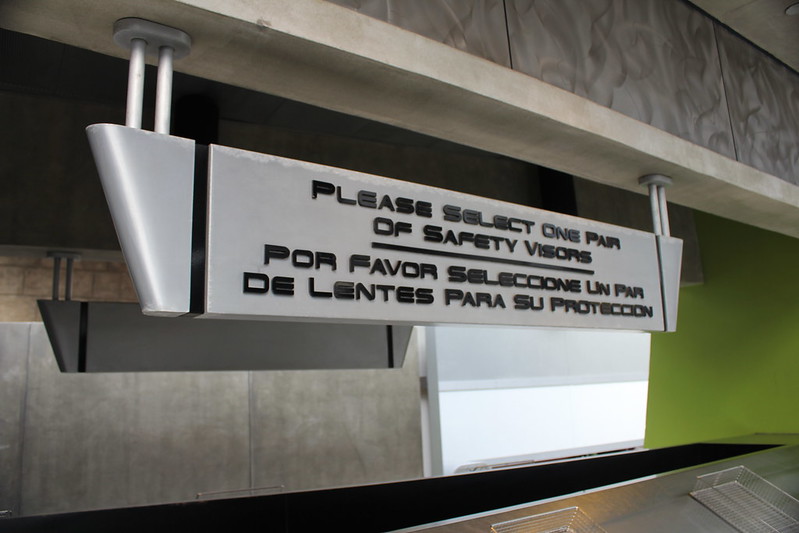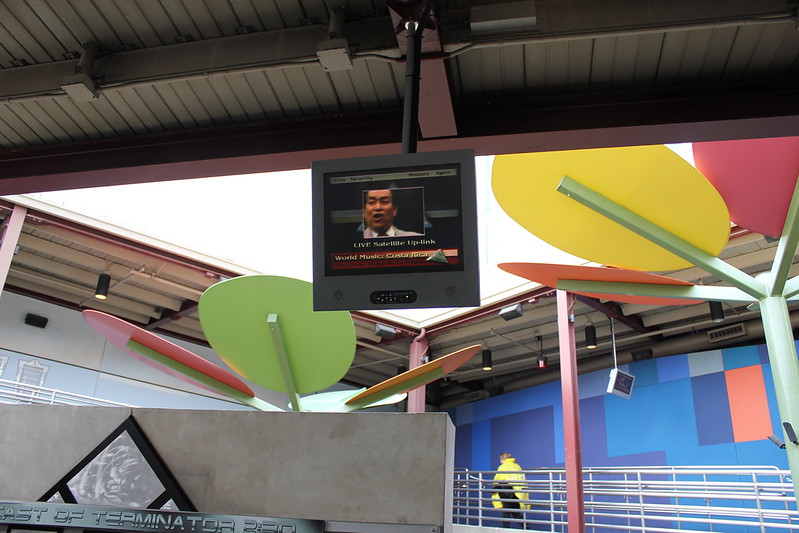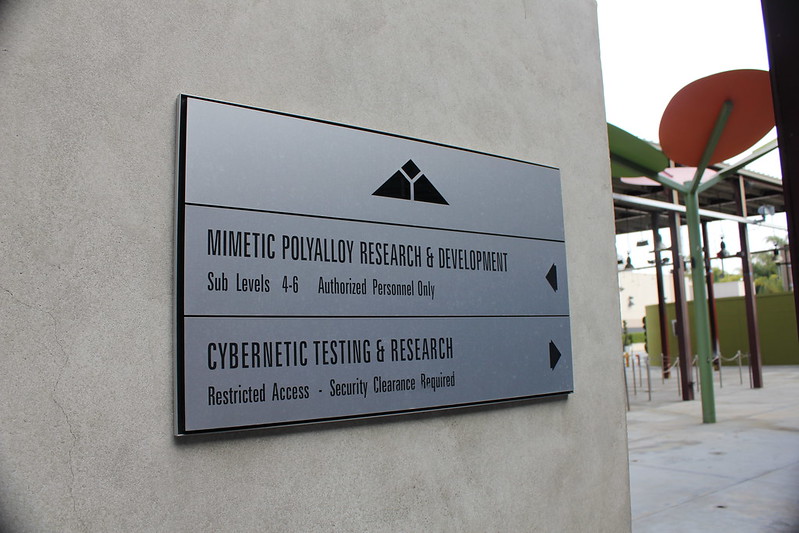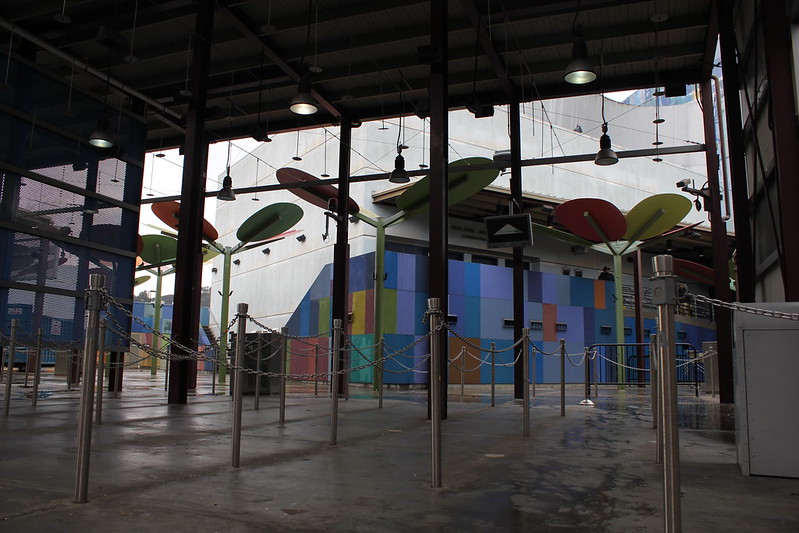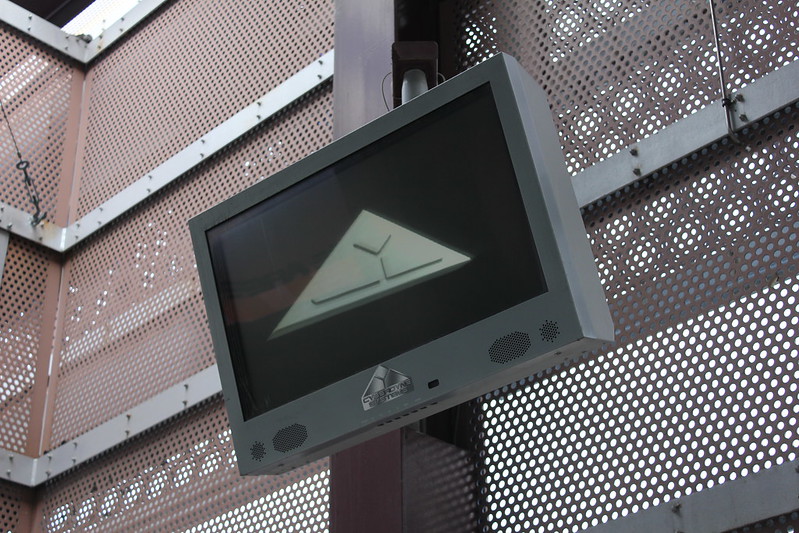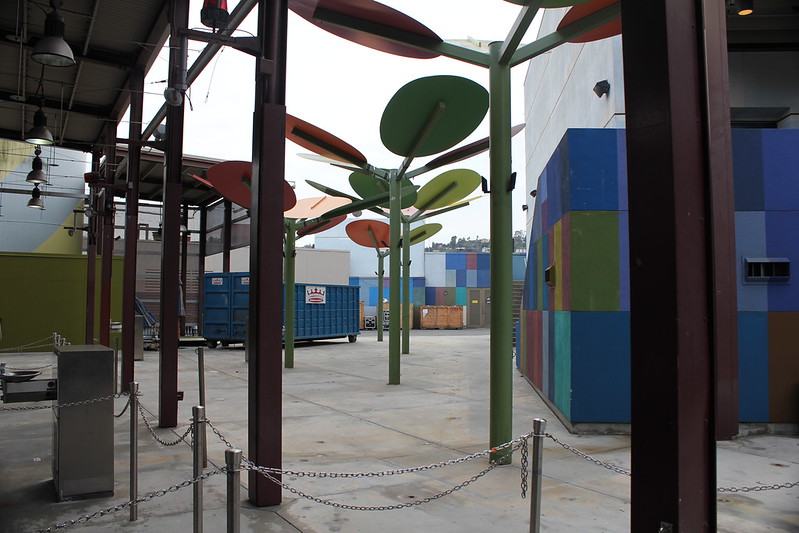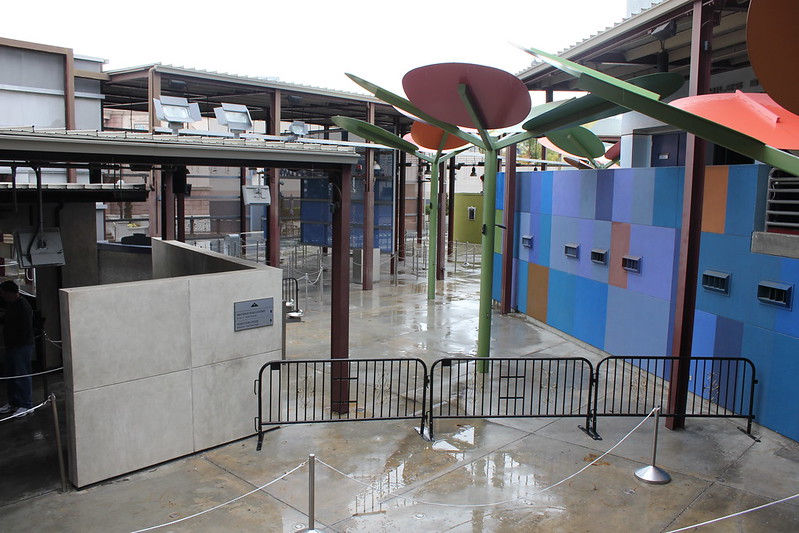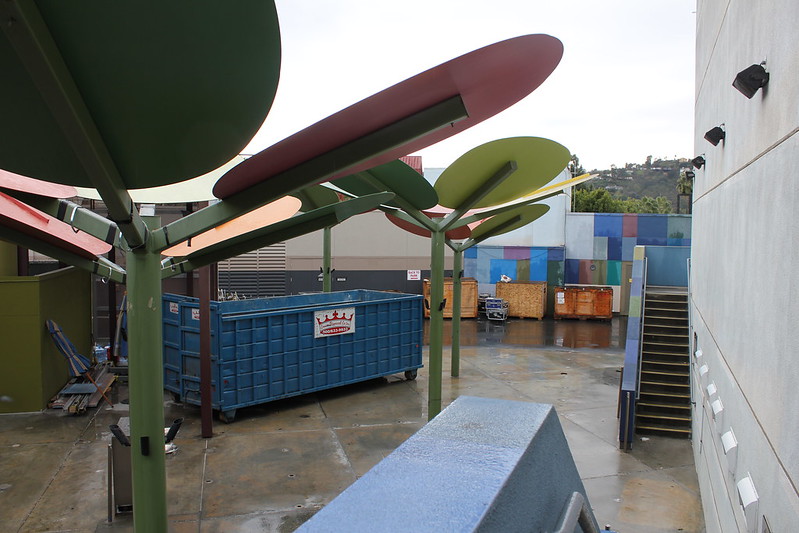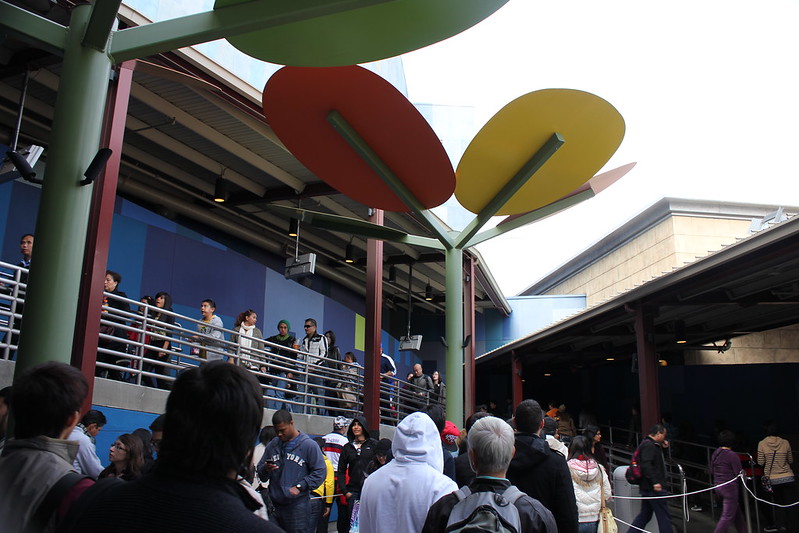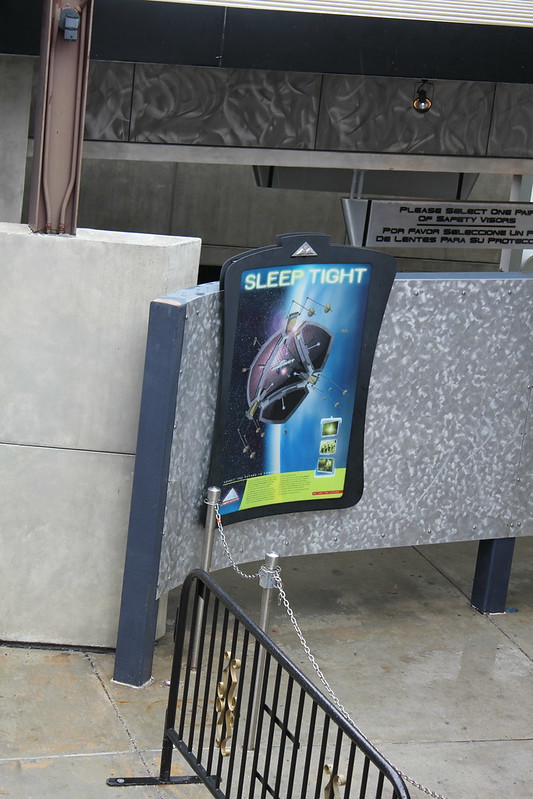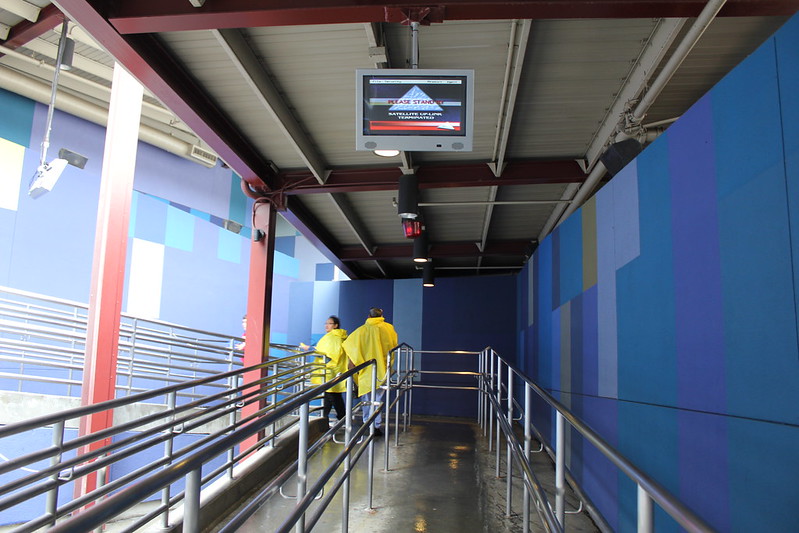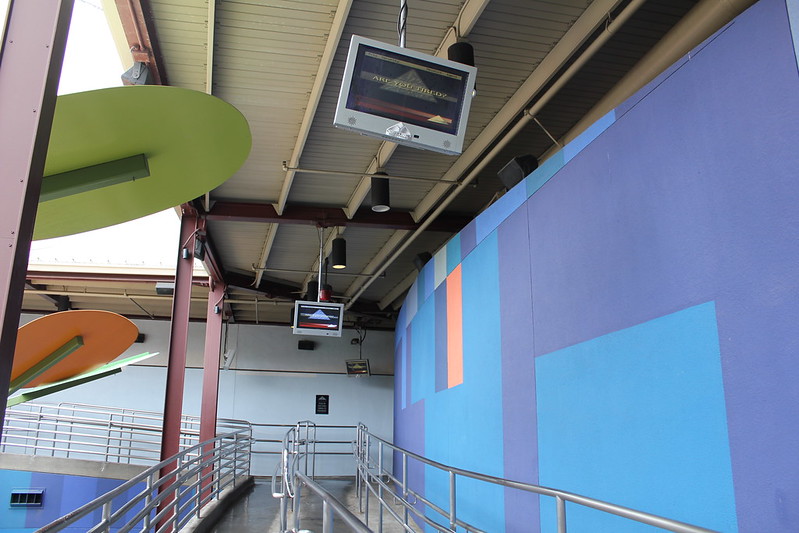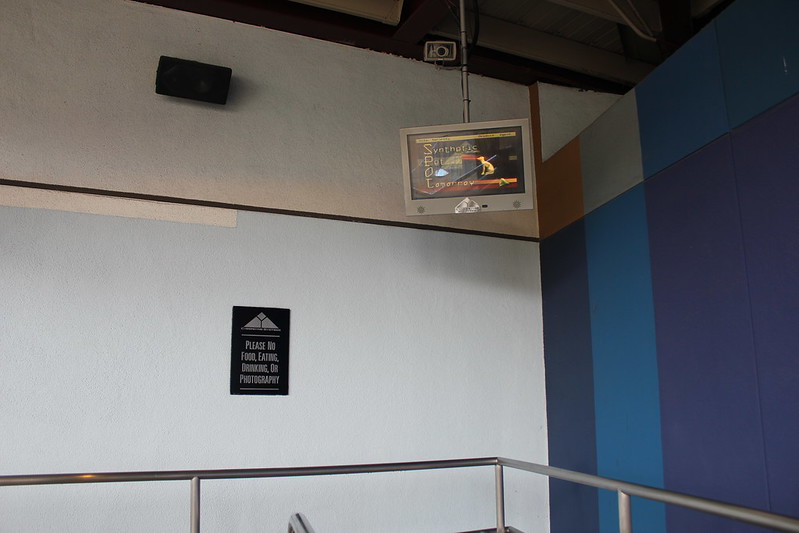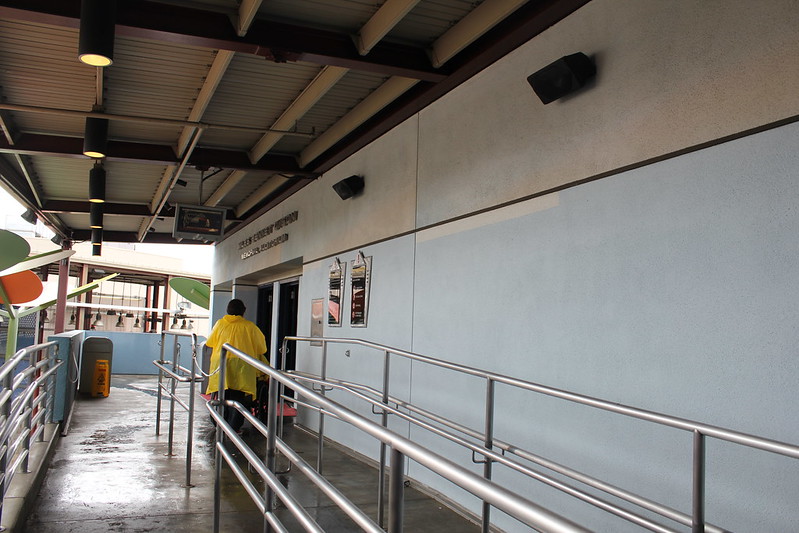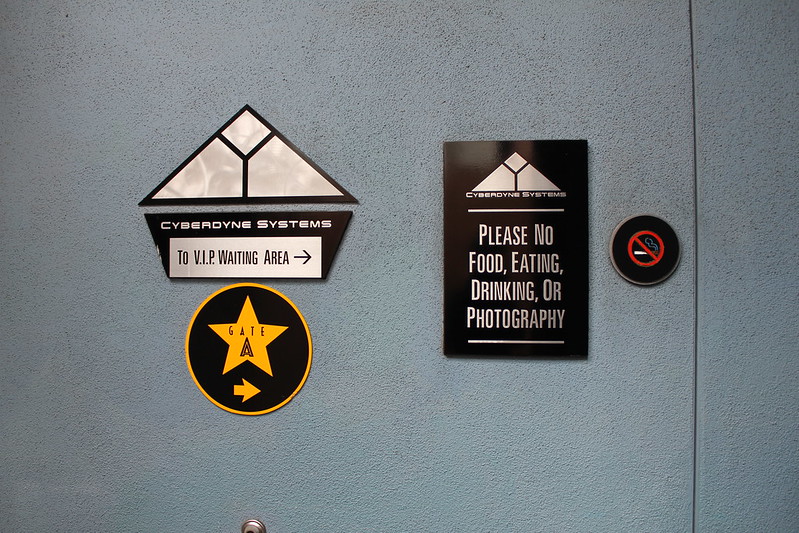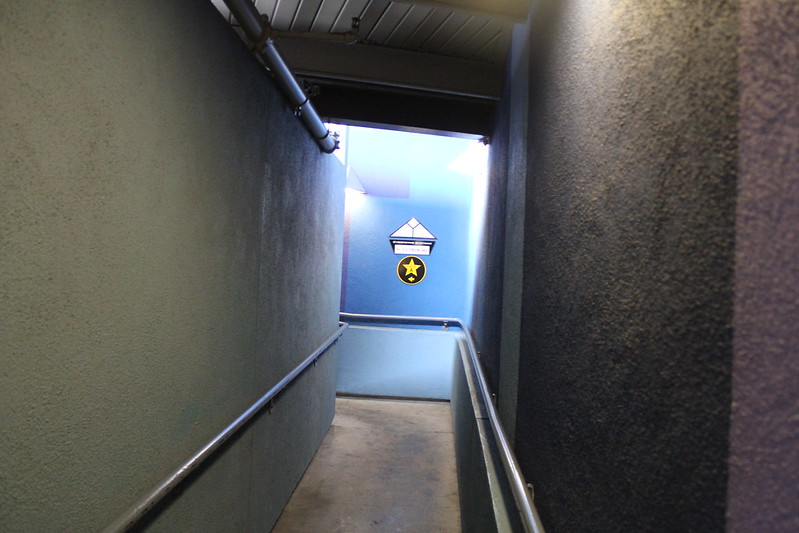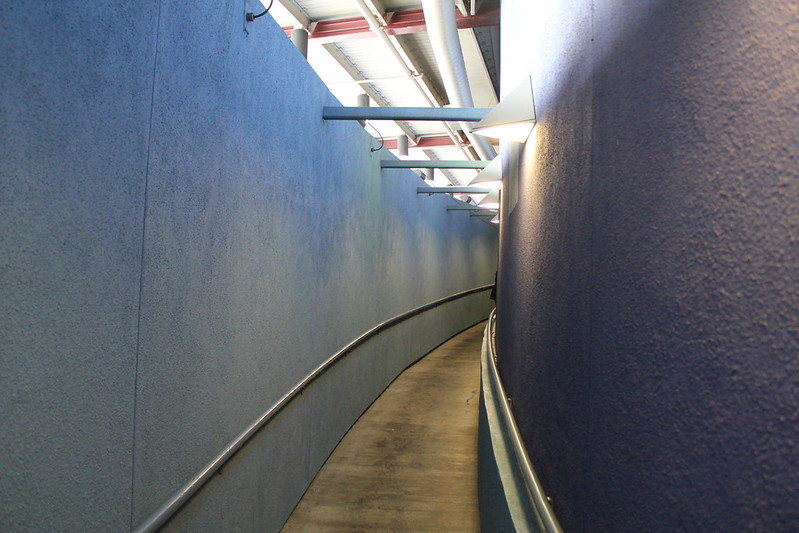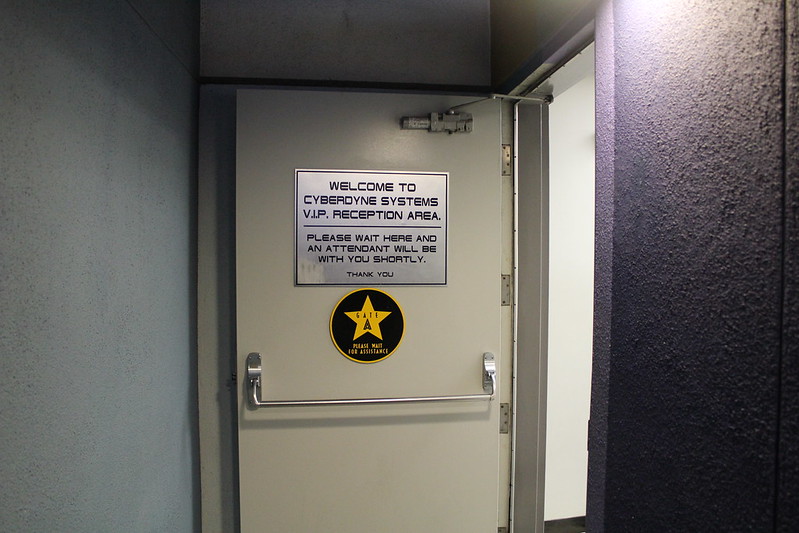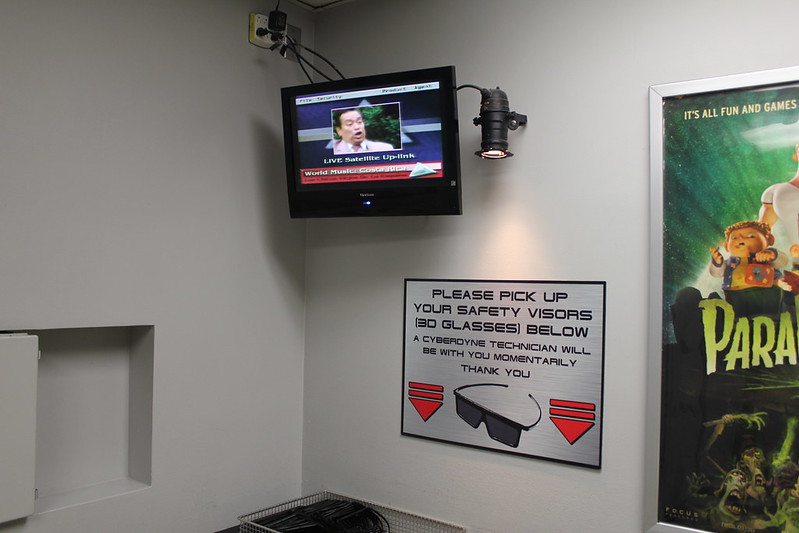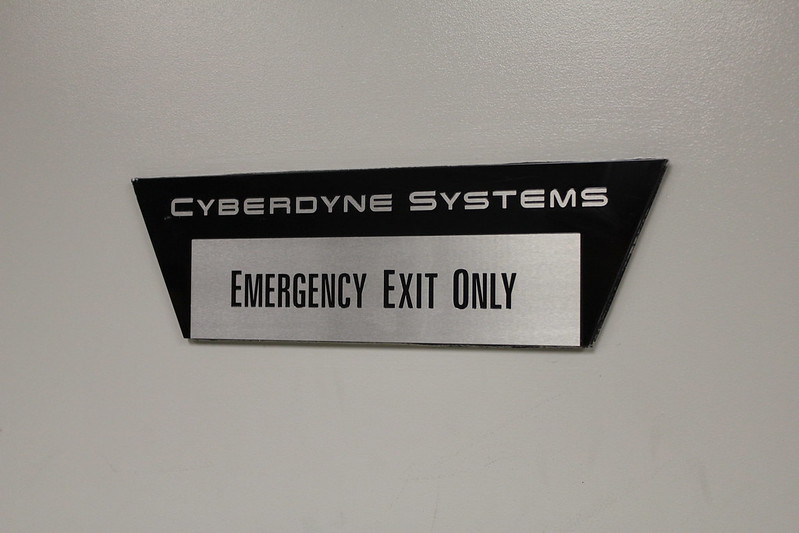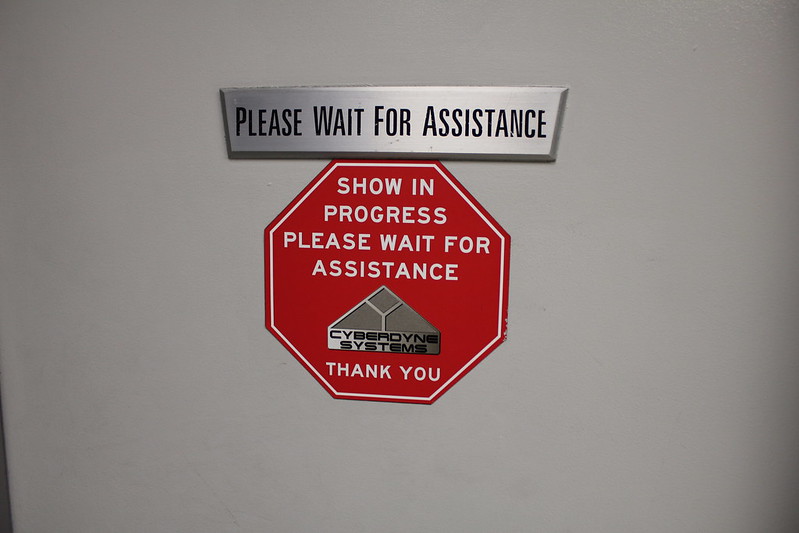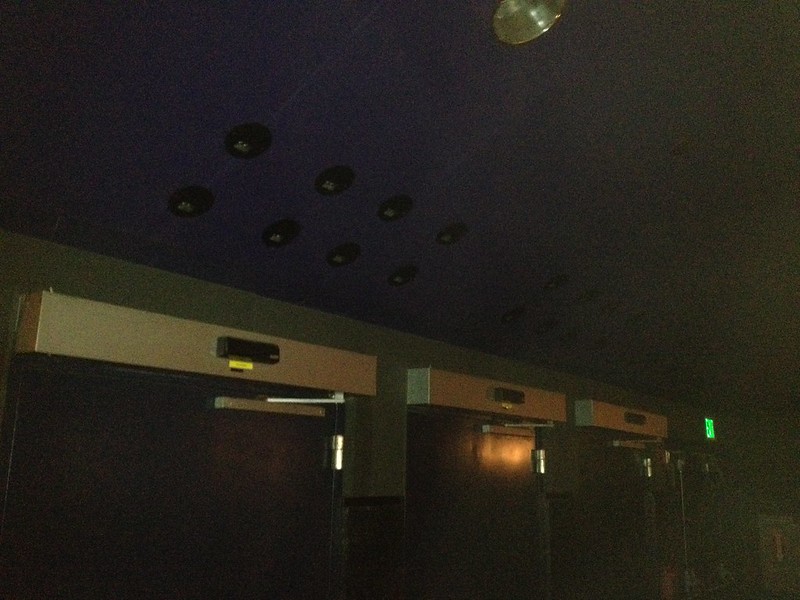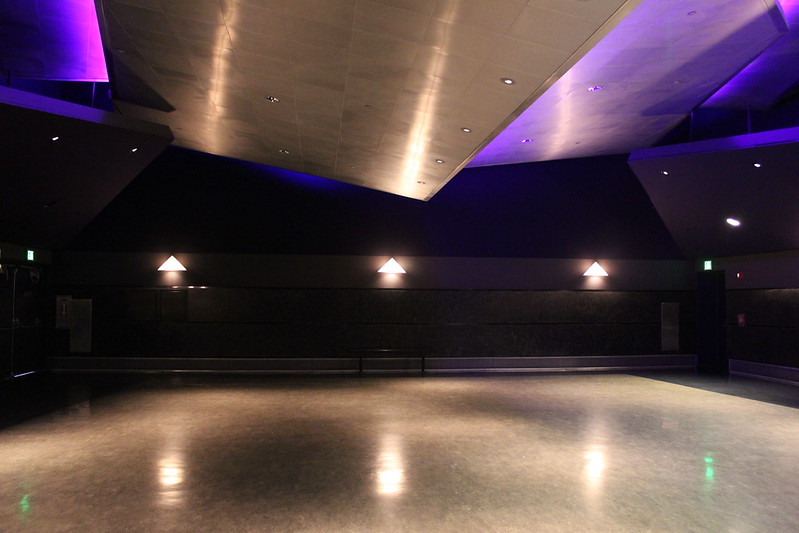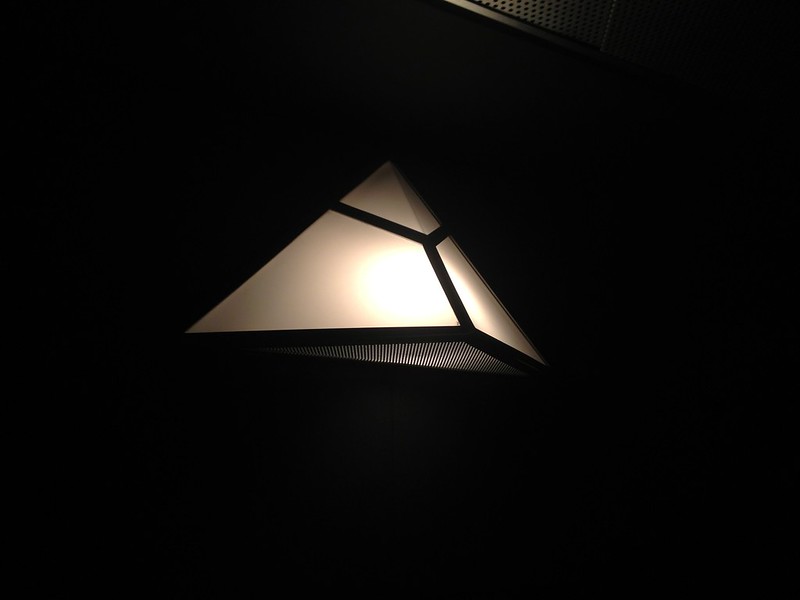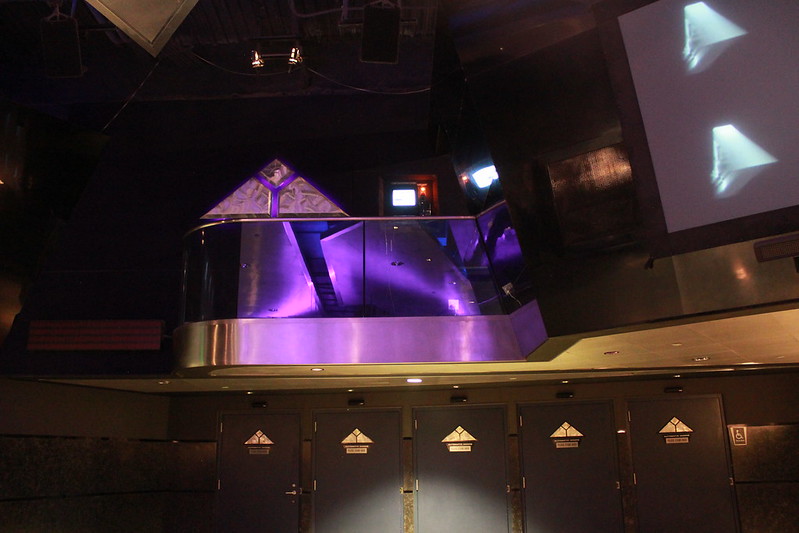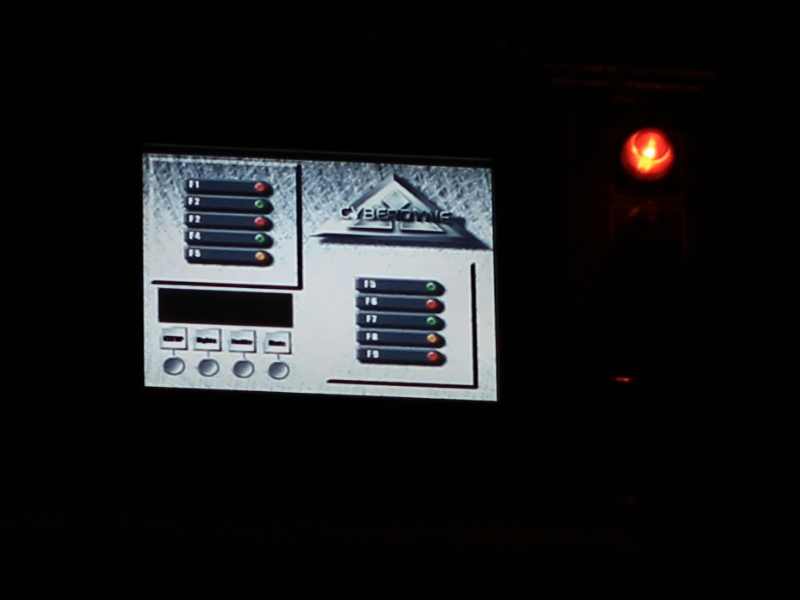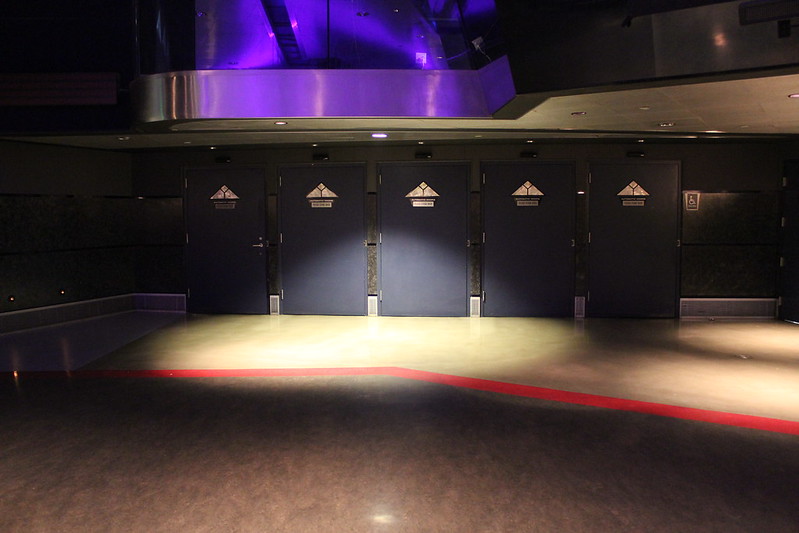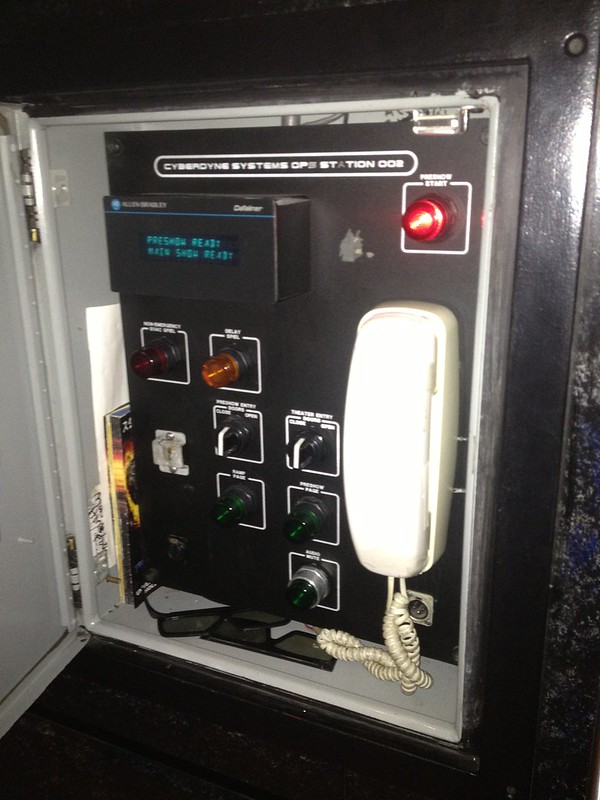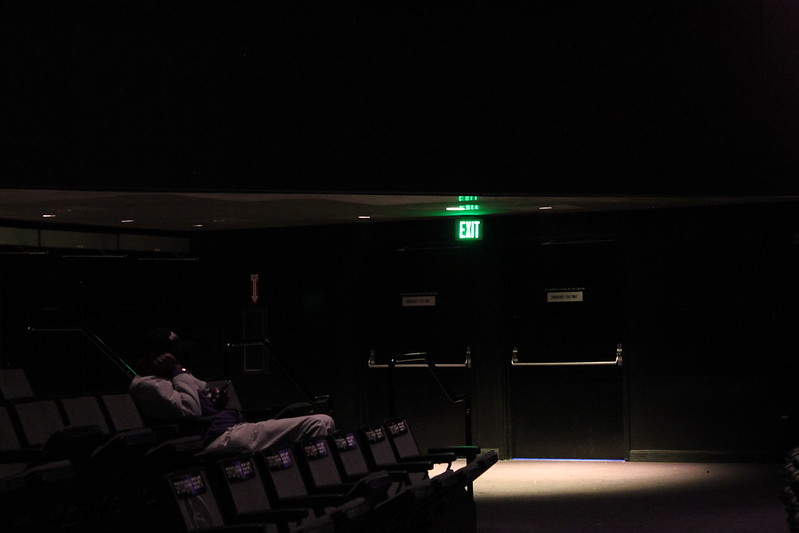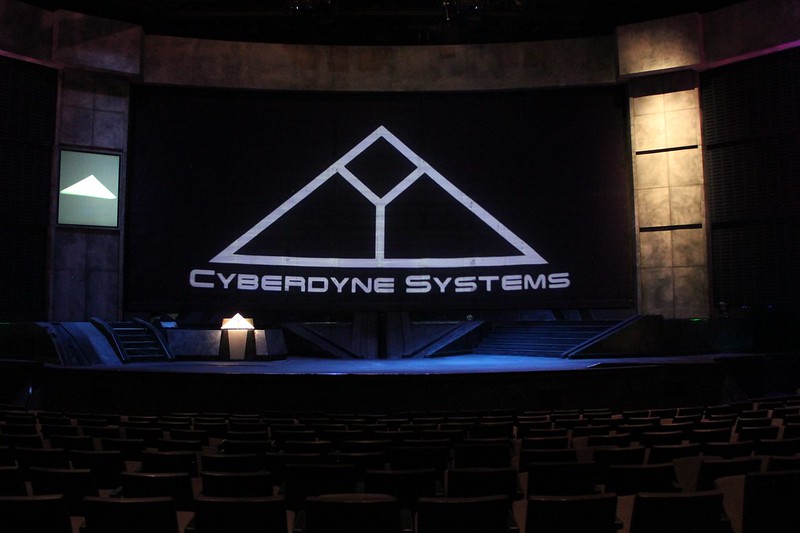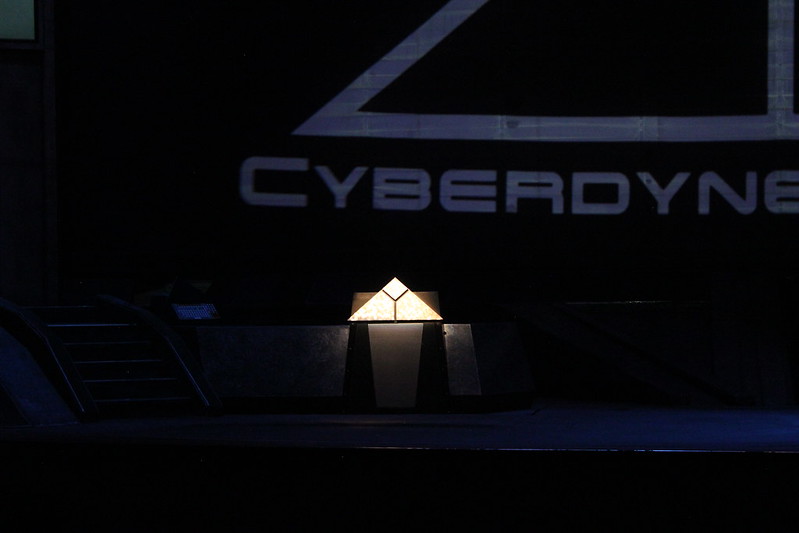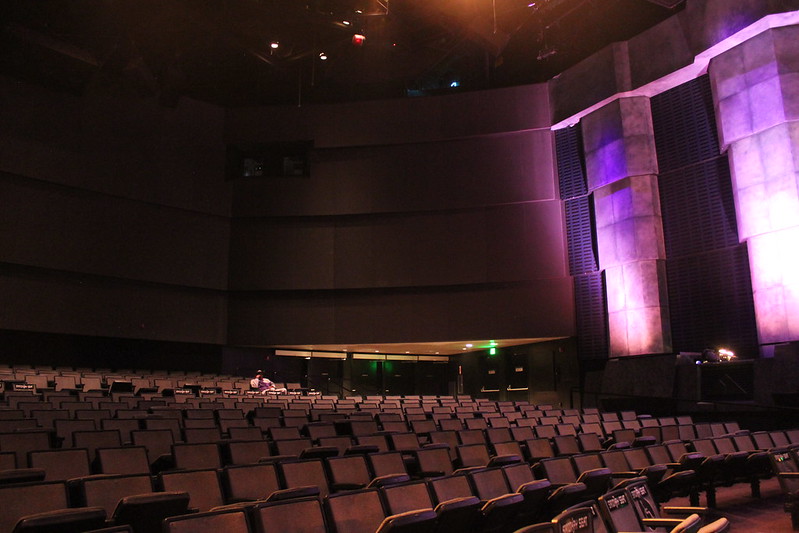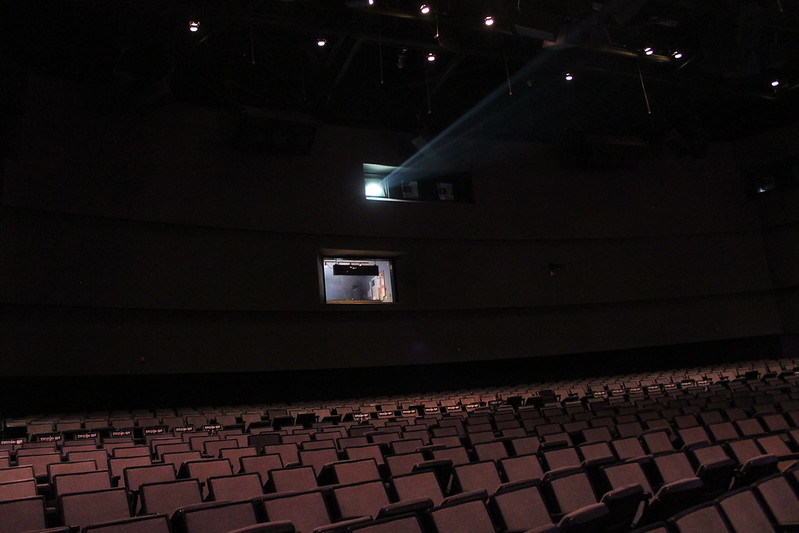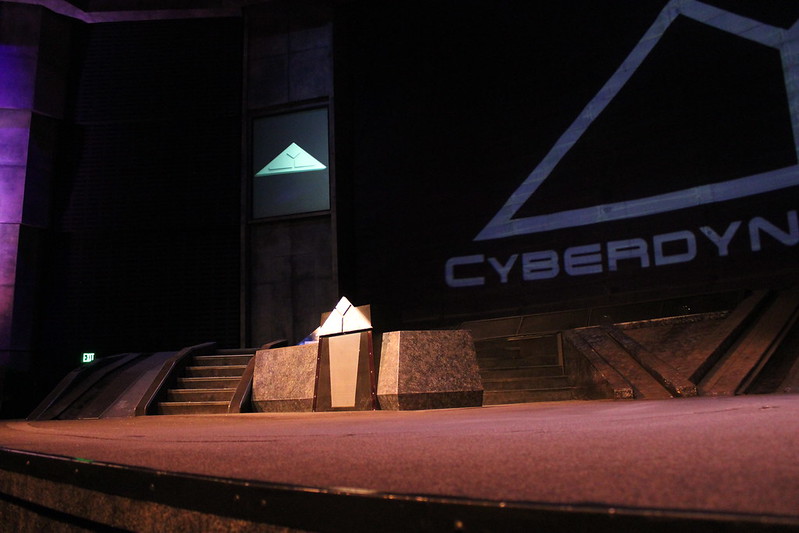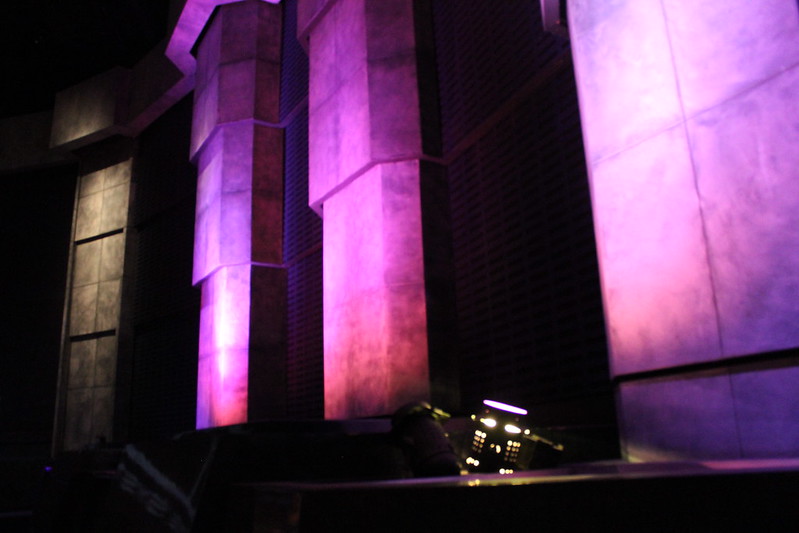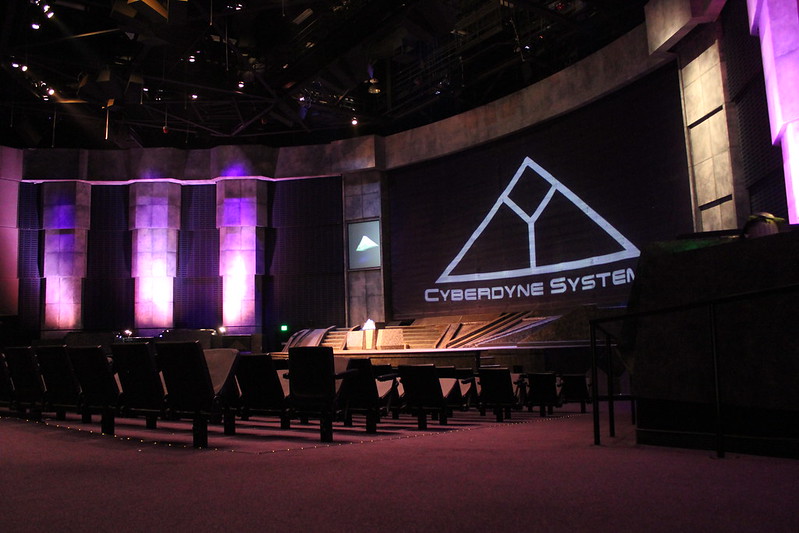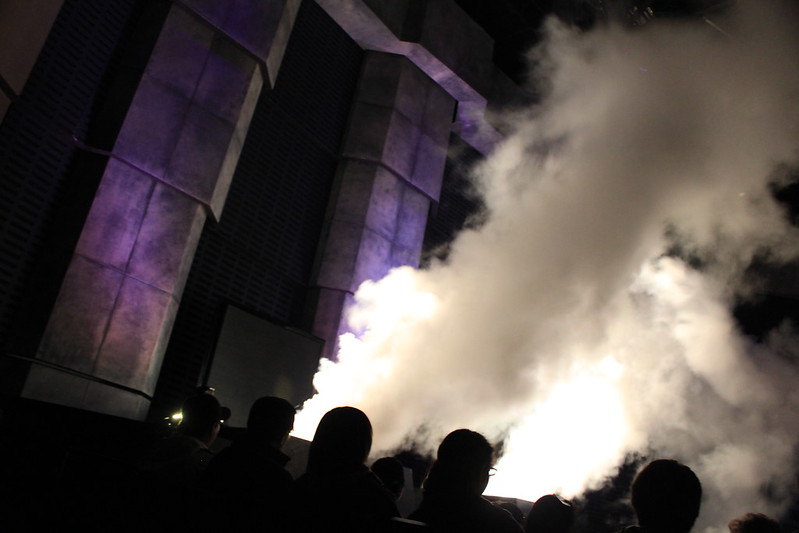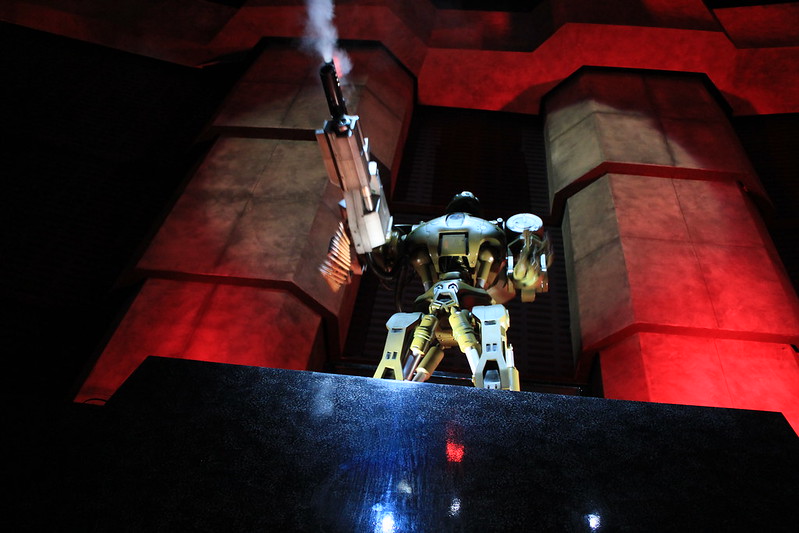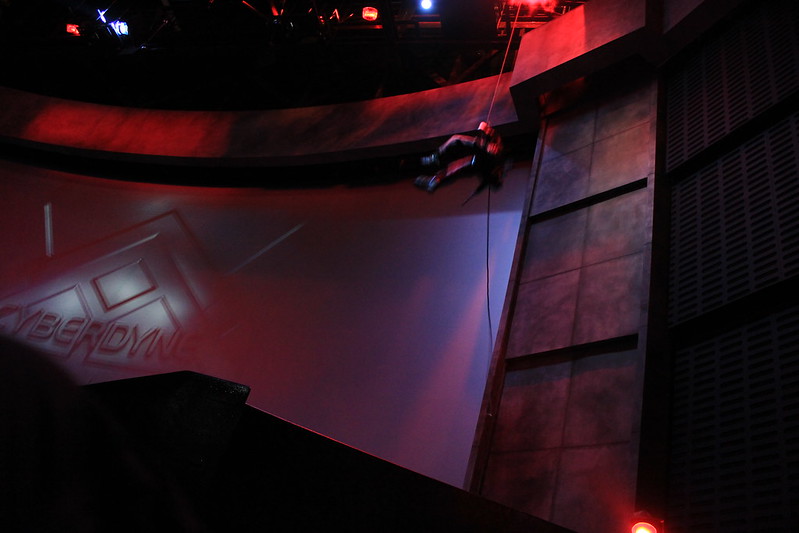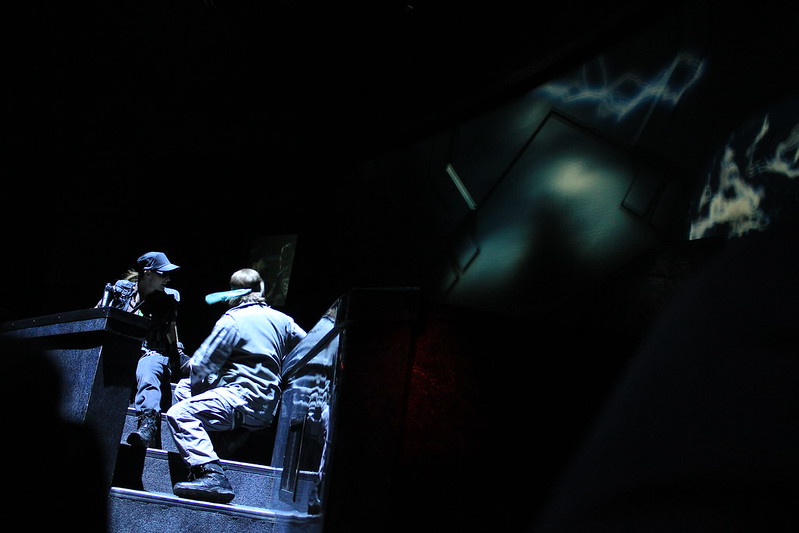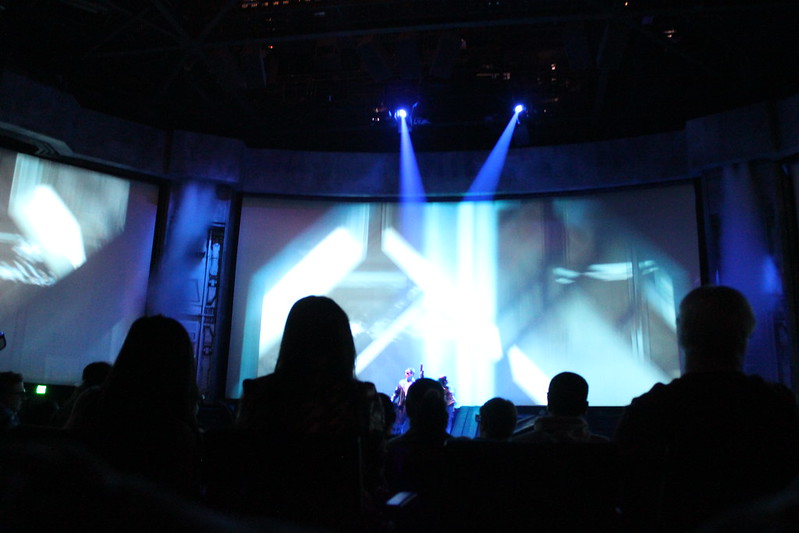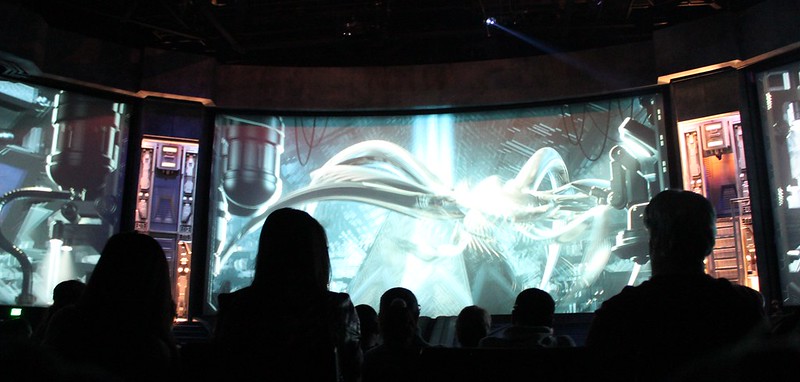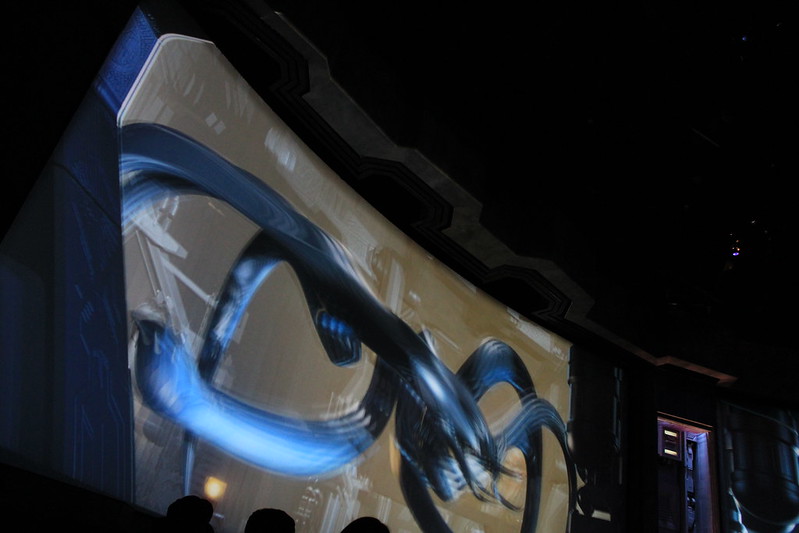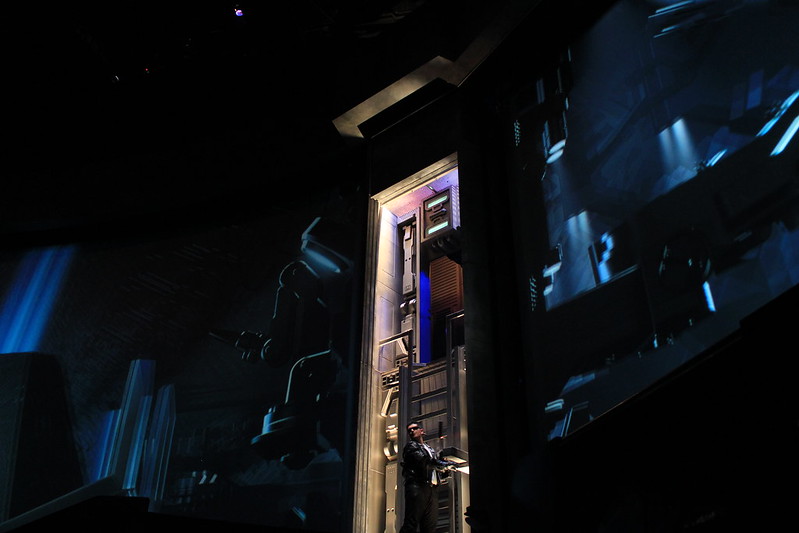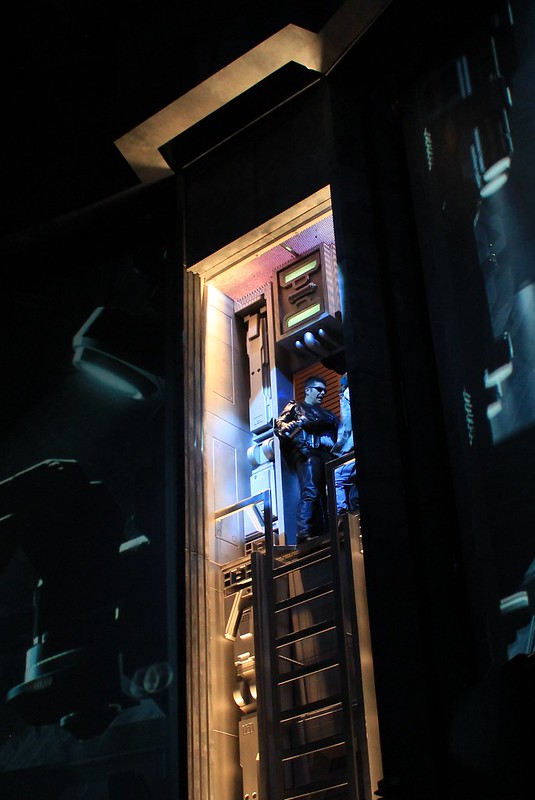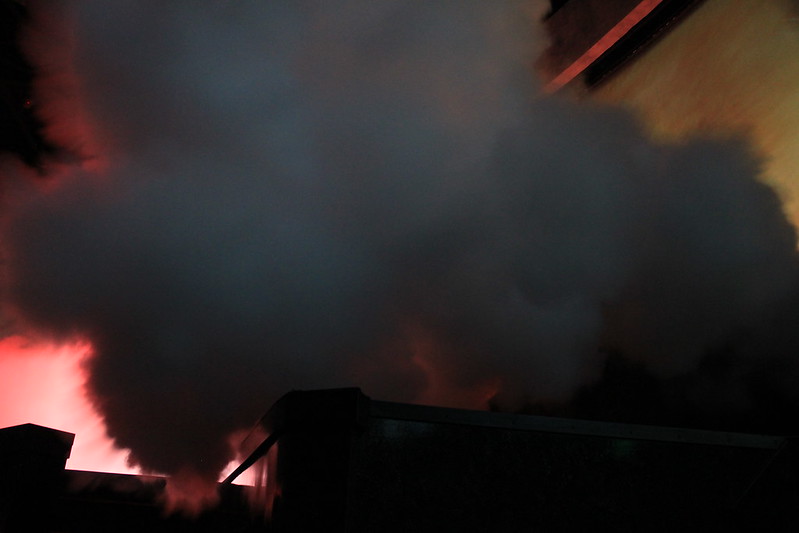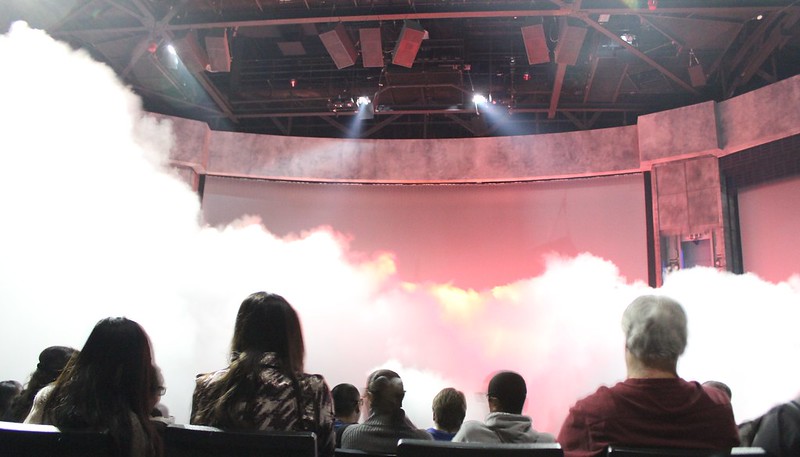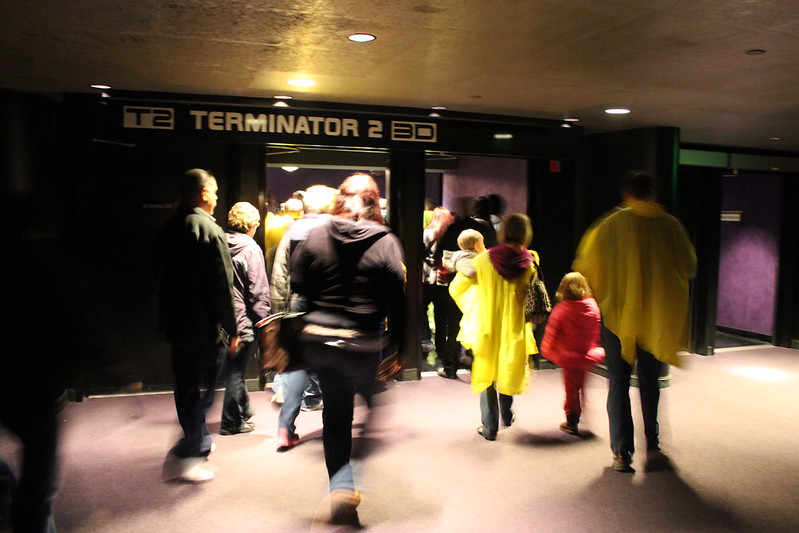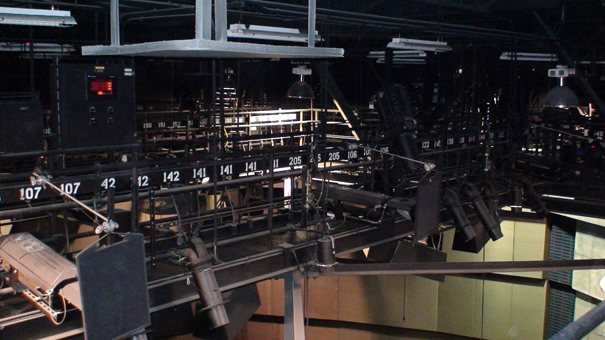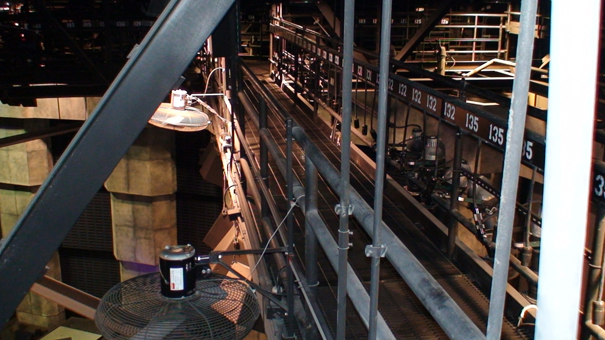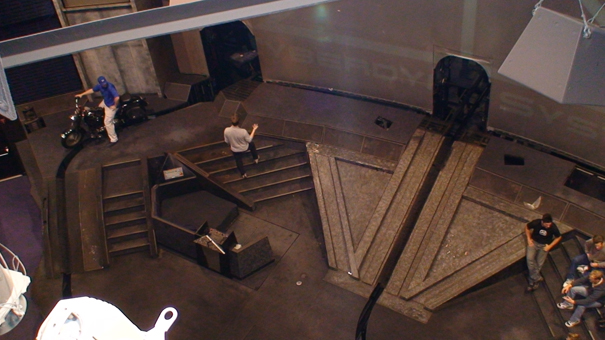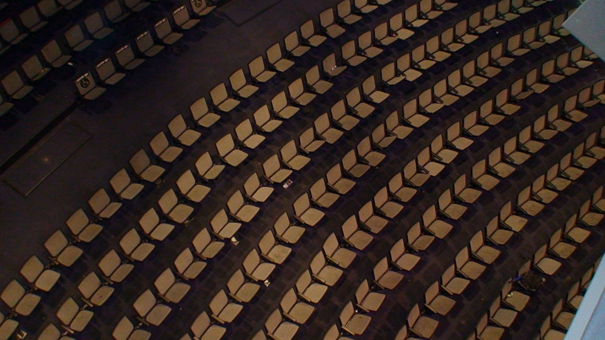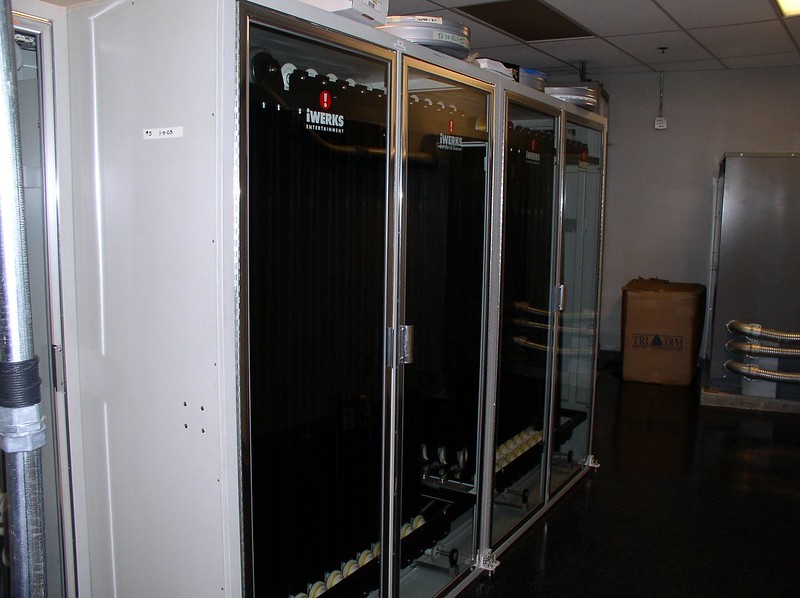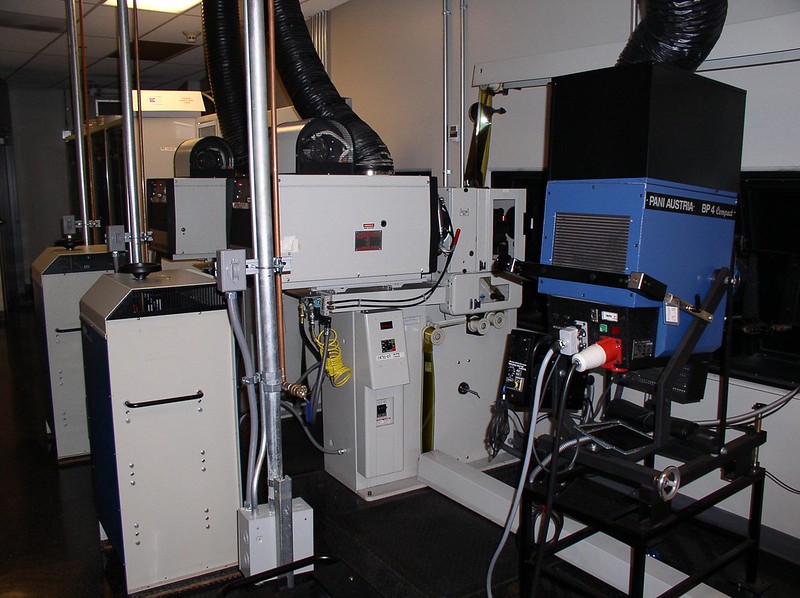
As part of our continuing coverage of Terminator 2:3D at Universal Studios Hollywood, we’re going to take an inside look at Cyberdyne Systems – America’s leader in defense technology and consumer products. Let’s get started.



Before we get started, let’s talk about that entrance. Many of you are probably familiar with Terminator 2:3D’s iconic blue glow – especially at night – typically at the end of Baker Street or at the corner of Coke Soak. Interestingly enough, that blue glow has a fascinating story. Unlike Terminator 2:3D at Universal Studios Florida and at Universal Studios Japan, Universal Studios Hollywood developed their own unique entrance to cater to the Hollywood crowd. In contrast to Florida and Japan’s “corporate office” feel, Hollywood specifically designed our exterior for maximum guest “impact.”
So in other words, it is often said that the executives believed an overblown and attention-seeking facade would drive up T2’s turnstile count. I guess you could say it worked – to an extent. But many fans believed Universal sacrificed proper theming in lieu of this unique facade.
But over the course of its 13-year history, Terminator has had two major changes to its sign: Terminator 2:3D – Battle Across Time (like Japan and Florida) and the current Terminator 2:3D in jagged, blue-accented text.
The current Terminator 2:3D entrance – as seen from Baker Street.
Terminator 2 has two main entrances: main (for most park guests) and Gate A. More on that in a few.
An empty area for additional seating. Note the three Terminator product signs. Let’s take a closer look.



“The Series 800 Terminator is a cybernetic organism: living tissue over a metal endoskeleton. The Terminator (played by Arnold Schwarzenegger) is a Series 800, model 101. By utilizing living tissue in the Series 800, Skynet improved upon the Series 600 Terminator which used rubber skin. The Series 800 was much more difficult for the human resistance to recognize than earlier versions of the Terminator. Skynet also uses the 800 series as its basic infantry for ground combat; in these conditions, the endoskeleton operates without any skin.”


“The Series 1000 Terminator is an advanced prototype composed of mimetic polyalloy. This liquid metal assassin can change shape at will, making itself into an exact replica of anything it samples by physical contact. The T-1000 can emulate humans… inanimate objects… and a variety of knives and stabbing weapons. The T-1000 was played by Robert Patrick when it morphed into the form of a motorcycle police officer.”

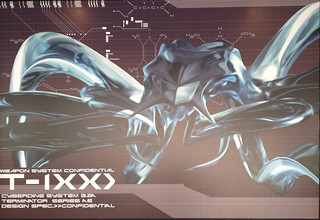
“The most lethal Terminator of all was created to guard Skynet¹s central core. The T-1,000,000 is a massive creature composed of liquid metal with deadly tentacles poised to attack anyone who dares to enter Skynet. The T-1,000,000 can be seen only in the Terminator 2: 3D attraction at Universal Studios.”
But focusing back on the main entrance, let’s take a look at T2’s “rules and regulations” signs.
By the way, notice anyone in this photograph?
The infamous Parental Discretion sign. Too bad Universal is straying away from this type of attraction. You won’t be seeing anything like Terminator anytime soon.
No photos, videos, food or drink or wet clothes. Perfect! Let’s head into the queue.




Like we mentioned above, Terminator’s queue is divided into two sections: “main” and Gate A.
The “main” queue is what most guests normally enter through to access the main attraction. It extends to the left of the building into a series of sections that eventually lead up to the main preshow room. There are also outdoor portions in Terminator’s courtyard, as well as further extensions in the back of the main show building (which have – unfortunately – not been used in years). Most sections of the queue also feature outdoor monitors that play an endless loop of CDYN – Cyberdyne’s interactive network – as well as various music loops that play in full (such as the now infamous “La Bamba” clip). There are also live security cameras that are featured in the queue’s video loop – adding to the illusion that Cyberdyne is constantly monitoring your activity.
On the other end, we have Gate A – a shortened entrance for VIP Experience or Front of Line pass holders. For the most part, Gate A’s queue is nestled from the main queue via a series of walls that lead up to a small room with one monitor – the notion being that Gate A pass holders should never exceed the capacity of that room.
The turnstiles, which splits the “main” queue into two portions that lead up to the preshow room.
Fun fact: this used to be painted orange. We’ve been told that green was selected to reflect General Electric’s “Green is Universal” campaign when they held the event in this theater.
A guest counter, which is supposedly hooked up to the two turnstiles we mentioned earlier.
Of course, guests must always wear a pair of safety visors before they enter into the main auditorium.
A board for the cast of Terminator.
A glimpse of the “La Bamba” clip alongside the final section of the queue.
The first “overflow” expansion queue – almost always used.
SunBrite weather-resistant LCDs were chosen to replace the old Panasonic monitors. We’re told these cost a pretty penny, and the queue’s littered with them!
What’s left of the extended queue.
Traces of Halloween Horror Nights are still evident in the extended courtyard. Sad, really.
The last of Cyberdyne’s product posters. Just think of a glorified SkyMall article, and you’ll have one of Cyberdyne’s displays.
Look closely at the monitor, and you can see one of Cyberdyne’s many products – this time they’re selling a robotic dog. Interesting. Also note the security camera that is fed into the queue video loop.
To conclude the “main” queue, we have the entrance to the Miles Bennet Dyson Memorial Auditorium.
In the meantime, let’s head on over to the Gate A/Front of Line lounge, and see what’s happening..
So as you can see, the VIP queue is literally surrounded by walls. Very narrow.
The main queue is just to the left of this wall.
The main VIP lounge. Employee door is to the right, while the emergency exit/preshow room is to the left. Odd tidbit: I’ve been told the tile flooring was modeled after the hospital scene in Terminator 2.
Of course, VIP gets its own special monitor!
This door leads to the main preshow, which concludes the VIP lounge. Let’s head through the door and see what’s up!




The preshow. Guests would usually enter through the doors, attempt to find seating, and eventually succumb to the fact that this was yet another standing room that would hopefully lead to the main attraction (rumor: designers purposefully made the preshow room cramped and claustrophobic – continuing the theme of Cyberdyne’s overbearing corporate atmosphere). Kimberley Duncan – Cyberdyne’s director of “community relations and media control” – would proceed to play an overtly suspicious corporate PR video. The Connors, unsurprisingly, would hack in and make their presence known to unsuspecting and oftentimes surprised guests.
As you would later see, Hollywood decided to implement a different design that differed from that of Florida, and eventually Japan. In many regards, Universal Studios Hollywood changed many of the technical element that were used in Universal Studios Florida and accommodated them to fit Hollywood’s unique T2 constraints.
Let’s take a closer look at what Hollywood has to offer!
The main entrance.
The ill-fated guest counters. From what I’ve been told, they were much more trouble than they were worth. As expected, they were eventually scrapped, but their remnants remain even today.
Ceiling sculptures, which have always looked pretty good in my opinion.
Back of the preshow room. Note the triangular light fixtures.
The main preshow room – what many guests first see when they enter into the room.
Kimberley’s balcony.
A closeup of Kimberley’s control panel. If you look closely, you can make out “F1, F2, F3…” and so on. We believe this is is meant to simulate a touchscreen panel. Florida, in comparison, uses a much more simplified graphic.
Preshow projection screen. Take a note of the audio outlets next to the screen – unlike the ceiling speakers in place at Florida and Japan. Apparently, Hollywood’s decision turned out for the better. This room really does start the notion that “Hollywood sounds better” overall – including the preshow!
The main doors to the Miles Bennet Dyson Memorial Auditorium.
Don’t stand too close, or you’ll be horribly disfigured!
Preshow control panel. Among other things, Cybertechs can close and open the main doors, signal to the actor portraying Kimberley when the preshow room is ready, and mute the preshow music.




Without a doubt, Hollywood has the most heart thumping, awe-inspiring Terminator theater in the world. Despite its shortcomings (four T-70s instead of six), there is simply no competition. As the original Universal press release proudly states, “The astonishing Universal Studios Hollywood attraction, opening in Spring 1999, boasts the world’s largest 3-D installation and is also the first to utilize a triple screen configuration. Stereo cinematography is projected from three sets of Iwerk twin-interlocked 65mm projectors onto three 23′ x 50′ screens. The massive screens are arranged at 60 degree angles to totally immerse the audience into the action.”
That’s not all. We’d be crazy if we skipped over the audio. Simply put, as we’ve mentioned time and time again, Hollywood has the most aggressive audio installation of Terminator in the world. Again, referring back to that original 1999 press release, “Terminator 2: 3D features a state-of-the- system: art sound system created by Soundelux that pumps a total of 45,620 watts through 159 speakers. The result-one of the most technically advanced sound systems in the world. All processing equipment-from mixers to crossovers-for the attraction’s audio set-up will be housed within one computer system. Using cutting edge computer software, all audio system connections and configurations will be made on screen, producing a singular sound sensation unique only to Terminator 2: 3D.”
Let’s take a tour of the theater to see what makes Terminator scream.
The main entrance gates from the preshow into the main auditorium.
Cyberdyne logo is proudly displayed, while guests are told to head to the furthest seat in every row. A soothing, if not condescending voice assures guests that every seat offers the same experience.
Kimberley’s main control podium.
Looking back at the auditorium’s entrance and the theater’s seating. The faint smell of gunpowder from the last performance taints the air.
The “pre-board” projector is on, while the performance projectors are still in standby.
Closeup of the main stage.
Something big happens here. *wink wink*
One last shot of the main auditorium before the performance starts.
The T-70! It should also be noted that Florida and Hollywood – oddly enough – share a different introduction. Compare Hollywood’s “armed combat has entered the digital age” to Florida’s “armed combat has entered into the age of robotics.” As expected, I prefer our dialogue…
“Automatic targeting systems active…”
“Prepare to fire. Lock and load. Commence firing.”
Sarah Connor makes her explosive entrance along with her son.
“I tried to warn you. Skynet means the end of everything, don’t you understand?”
“Time portal”
“Mom, it’s him!”
“I said I’d be back. Come with me if you want to live.”
“Where are we?”
“Home”
“It’s called the T-1,000,000. Move! Get out of sight!”
“Hit him again!”
“Let’s go! We don’t have much time. Up!”
“I’ll be back. Now go! Run!”
“Ahh!”
“Hasta la vista, baby.”
“Ladies and gentlemen, please exit the facility through the open doors to your right, and deposit your safety visors in the designated containers. Thank you.”
Looking from above, we have a glimpse of the equipment used during T2’s performances. Most notably, scanners, which nowadays are replaced by rotating heads.
Another shot of the equipment – including the fans.
The bike being run during rehearsals. You can see the open track below.
Terminator has a seating capacity of 696 people, with an average rotation capable of 2,400 people per hour.
“The custom-built Harley Davidson “Fat Boy” used in the live-action sequences of the attraction tips the scale at a hefty 1,500-pounds.”
Terminator 2’s film cabinets.
“Utilizing the most sophisticated digital system: imaging technology ever created, “Terminator 2: 3D” requires six fully automated 70mm Iwerks projectors to launch the 3-D images onto the three massive 23’x50′ screens. The world’s largest 3-D installation, spanning 165 feet, the “Terminator 2: 3D” screen will engulf guests in 180 degrees of awe-inspiring excitement.”


So this concludes our special behind-the-scenes look at Terminator 2:3D at Universal Studios Hollywood. A huge thanks goes out to the crew and cast of Terminator 2:3D, of whom this coverage would not have been possible. The amount of gratitude this site expresses – and myself personally – to T2’s team cannot be measured. We express multitudes of thanks to them for allowing us to bring this coverage to you. Hopefully we met their expectations.
And on a more personal note, while I have criticized this attraction for being woefully outdated at times, most of content from which this criticism stems (preshow and queue video) can easily be fixed. It’s a shame Universal isn’t willing to update the attraction, but given their current situation, it’s understandable – if not hard – to accept. I have always maintained that Terminator – to date – is still the most immersive and innovative 3D show in the world and I, like many others, will be saddened to see it go. It was a great 13-year run, and it will be missed.
For me personally, this show emphasized the Universal experience: an explosive, no-holds show that pulls all the punches. Add to the fact that the cast here in Hollywood have always made the show their own (despite the heavily scripted dialogue) all made for a very special experience. For whatever reason, the actors – especially those who portrayed Kimberley – have always had the unmistakable Hollywood touch that fit the role perfectly that made our Terminator not at all like a normal theme park show (sorry, Florida). I’ll miss that L.A. attitude most of all, especially after having gone to T2 in Japan and Florida where that same attitude is notably absent.
Anyway, thanks for taking the time to explore Terminator with me, and stay tuned for our continuing coverage.


About the Author: Jon Fu
Jon Fu is the editorial director of Inside Universal and oversees the creative direction of the site’s content.
Jon originally founded InsideUniversal.net in 2006 as a summer hobby aimed at providing families and fans a resource for all things “Universal Studios Hollywood.” Since then, the website has taken him throughout the United States and around the world – including to places like Universal Orlando Resort, Universal Studios Japan and Universal Studios Singapore.
Jon currently resides in Santa Cruz, California with his bamboo plant. You can reach him at jon@insideuniversal.net.




